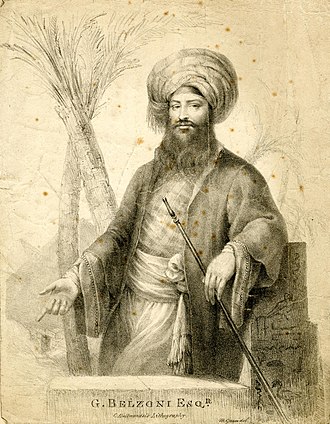Giovanni Battista Belzoni

Giovanni Battista Belzoni (Italian pronunciation: [dʒoˈvanni batˈtista belˈtsoːni]; 5 November 1778 – 3 December 1823), sometimes known as The Great Belzoni, was a prolific Italian explorer and pioneer archaeologist of Egyptian antiquities. He is known for his removal to England of the seven-tonne bust of Ramesses II, the clearing of sand from the entrance of the great temple at Abu Simbel, the discovery and documentation of the tomb of Seti I (still sometimes known as “Belzoni’s Tomb”), including the Sarcophagus of Seti I, and the first to penetrate into the Pyramid of Khafre, the second pyramid of the Giza complex.
Belzoni was born in Padua. His father was a barber who sired fourteen children. His family was from Rome and when Belzoni was 16 he went to work there, saying that he studied hydraulics. He intended on taking monastic vows, but in 1798 the occupation of the city by French troops drove him from Rome and changed his proposed career. In 1800 he moved to the Batavian Republic (now Netherlands) where he earned a living as a barber.
Portrait of Belzoni as a strongman
In 1803 he fled to England to avoid being sent to jail.[2] There he married an Englishwoman, Sarah Bane. Belzoni was a tall man at 6 feet 7 inches (2.01 m) tall (one source says that his wife was of equally generous build, but all other accounts of her describe her as being of normal build) and they both joined a travelling circus.[3] They were for some time compelled to subsist by performing exhibitions of feats of strength and agility as a strongman at fairs and on the streets of London. In 1804 he appears engaged at the circus at Astley’s Amphitheatre at a variety of performances.[4] Belzoni had an interest in phantasmagoria and experimented with the use of magic lanterns in his shows.
In 1812 he left England and after a tour of performances in Spain, Portugal and Sicily, he went to Malta in 1815 where he met Ismael Gibraltar, an emissary of Muhammad Ali, the Pasha of Egypt, who at the time was undertaking a programme of agrarian land reclamation and important irrigation works.[5] Belzoni wanted to show Muhammad Ali a hydraulic machine of his own invention for raising the waters of the Nile. Though the experiment with this engine was successful, the project was not approved by the pasha. Belzoni, now without a job, was resolved to continue his travels. On the recommendation of the orientalist J. L. Burckhardt he was sent by Henry Salt, the British consul to Egypt, to the Ramesseum at Thebes, from where he removed with great skill the colossal bust of Ramesses II, commonly called the “Younger Memnon”. Shipped by Belzoni to England, this piece is still on prominent display at the British Museum in London. This weighed over 7 tons. It took him 17 days and 130 men to tow it to the river. He used levers to lift it onto rollers. Then he had his men distributed equally with 4 ropes drag it on the rollers. On the first day (27 July) he only covered a few yards, the second he covered 50 yards deliberately breaking the bases of 2 columns to clear the way for his burden. After 150 yards, it sank into the sand, and a detour of 300 yards on firmer ground was necessary. From there, it got a little easier, and, on 12 August, he finally made it to the river where he was able to load it on a boat for shipment to England.[6] His excavation and removal of the Younger Memnon and other stones during this expedition was explicitly authorized by a firman from Muhammad Ali himself.
